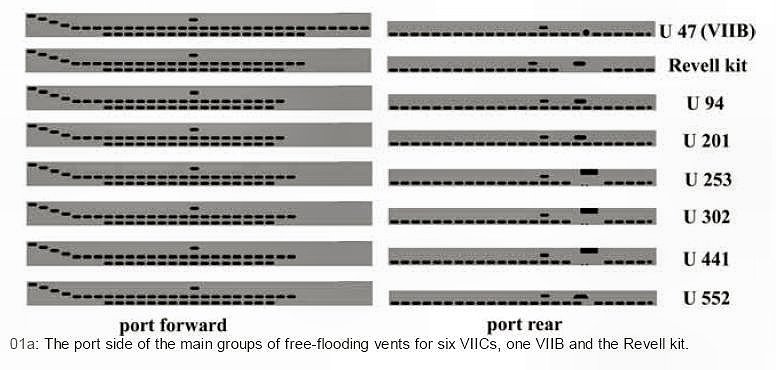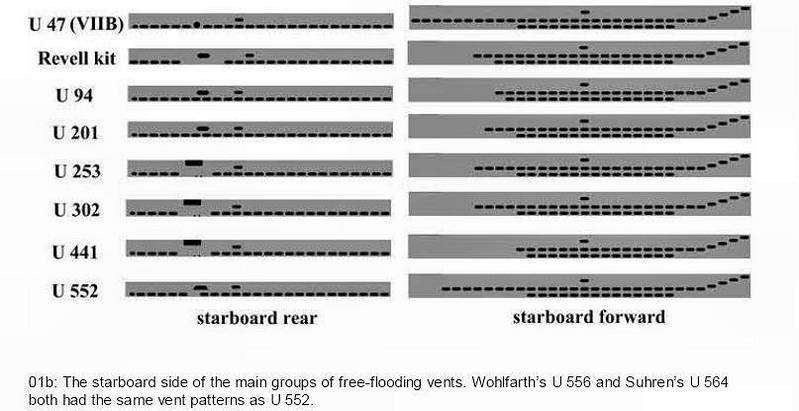You are viewing the archived version of the site.
Go to modelshipwrights.com for the current dynamic site!
Go to modelshipwrights.com for the current dynamic site!
Type VIIC Free-Flooding Vent Patterns
Main free-flooding vent patterns
The two main groups of vents ran along much of the length of the boat, just below the top of the hull casing. One group of large-sized vents was located forward of the central drainage area (the area directly above the saddle tanks) and the other was located aft of the central drainage area. When a U-boat surfaced, water would pour out of these vents. In 01a and 01b, I have replicated the vent patterns of these main groups for several U-boats. My primary reason for selecting these boats was that I had enough photos of them to identify all the vents. As several photos from different angles are required, it can often be difficult to ascertain the vent patterns on a particular boat.

Note that even although U 94 and U 201 were both built at the Friedrich Krupp Germaniawerft A.G. shipyards in Kiel, there were still small differences in their vent patterns.
On 01b, the vents located forward of the central drainage area on the starboard side of U 552 can be seen. The 25 vents on the top row of the starboard side extended farther aft towards the central drainage area than on many other VIICs. I have also seen these extra vents on the starboard side of U 132, U 331, U 564, U 565, U 566, U 570 and U 751. All these boats had the same number of vents on the lower row as U 552 (14 vents), except for U 373 (12 vents) and U 751 (16 vents). I have also seen these extra vents on the starboard side on two unidentified boats built at the Kieler Howaltswerken shipyards in Kiel. As U 392 did not have them, these extra vents were not present on all Kieler Howaltswerken boats. Since these extra vents featured on boats from several different shipyards, and these shipyards produced boats without the extra vents, we cannot, unfortunately, specify that they were particular to one shipyard.
It can be seen from the drawings that the VIIB U 47 had even more vents directly ahead of the central drainage area (28 vents on the top row). These extra vents, present on both starboard and port sides of all VIIBs, are a characteristic of the VIIB that can be used to identify a VIIB from a VIIC.
By comparing the Revell vent patterns with the VIIC vent patterns, it becomes obvious that alterations should be made to the kit. In fact, the main groups on the Revell kit are not accurate for any VIIC. In the main four vent groups alone, 11 vents need to be drilled, 7 filled and 2 altered if U 552 is being depicted. A similar number is required for U 94: 10 drilled, 8 filled and 2 altered. In my opinion, Revell should have included the maximum number of vents for each group so that no drilling would have been required. Although this pattern would not have been accurate for any particular boat, it would have been a simple matter to fill in the necessary vents for the chosen boat.
The earliest VIICs had an unbroken line of 25 vents in the rear groups. When modelling these boats, four extra vents per side should be drilled out beneath the diesel exhaust outlets. Also in the rear groups is a vent located above the line of vents, just forward of the exhaust outlet. In the Revell kit this vent has been positioned above the wrong vent; it should be located one vent further towards the stern. The vent at the rear of the rear group in the Revell kit is an oval hole that is the same as the rest of the vents. However, this rearmost vent was actually different in shape to the rest. It was the same height, but far narrower in width. In fact, it was almost circular in shape. Except for the boats which had the extra vents on the starboard side, no drilling of the forward groups of the Revell kit is necessary. The vent patterns for the rest of the boats can easily be replicated by filling in the necessary vents.
Copyright ©2021 by Dougie Martindale. _OPINIONS Model Shipwrights, KitMaker Network, or Silver Star Enterrpises. Images also by copyright holder unless otherwise noted. Opinions expressed are those of the author(s) and not necessarily those of Model Shipwrights. All rights reserved. Originally published on: 2008-06-23 00:00:00. Unique Reads: 6337








